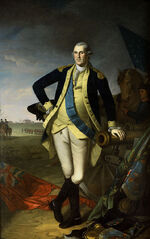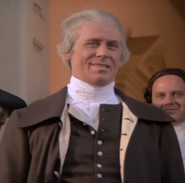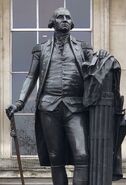
George Washington (22 February 1732 – 14 December 1799) was President of the United States from 30 April 1789 to 4 March 1797, preceding John Adams. Washington, the first President of the United States, was a Virginia soldier and farmer who had fought in the French and Indian War and served as commander-in-chief of the Continental Army during the American Revolutionary War. As the man who led America's army to victory over Great Britain, he was hailed as a national hero, and he was elected unopposed in both the 1789 and 1792 presidential elections. Washington set a precedent for future Presidents by leaving office after two terms, ensuring that America's democracy would outlive him. He retired from public life, and he died at his Mount Vernon plantation in 1799.
Biography
Early life

Washington in his militia uniform
George Washington was born in Popes Creek, Westmoreland County, Virginia in 1732 to a prosperous family of slaveholders. He was a successful surveyor and land investor before joining the Virginia militia, and he served in the French and Indian War, commanding men in only two battles: the first battle, the Battle of Jumonville Glen, started the war; the other battle, the Battle of Fort Necessity, was a defeat. Washington also served under General Edward Braddock during his Fort Duquesne expedition, which was defeated at the Battle of the Monongahela. In December 1758, he retired to his Mount Vernon plantation.
Marriage and civilian life
In 1759, Washington married the widow Martha Custis, but they could have no children, as Washington's bout with smallpox in 1751 made him sterile. From 1758 to 1765, he represented Frederick County in the House of Burgesses, and he doubled the size of Mount Vernon and gained more land into what is now West Virginia. He lived an aristocratic lifestyle, and he embraced Enlightenment values and joined the Freemasons.
American Revolutionary War
At the start of the American Revolutionary War in 1775, the Second Continental Congress met in Philadelphia to discuss the colonial response to the Battles of Lexington and Concord. On 14 June 1775, John and Samuel Adams nominated Washington to become commander-in-chief of the newly-created Continental Army, which awaited him in Cambridge, Massachusetts. Washington, a humble gentleman, wore his militia uniform to the Congress, and he declined a salary in his acceptance speech, reluctantly accepting the title of commander-in-chief. By the time he had arrived in Cambridge, the Battle of Bunker Hill had been fought, and the war had drastically escalated.
Commander-in-chief

Washington crossing the Delaware River
Washington took command of a poorly-trained and ill-equipped volunteer army that was besieging the city of Boston, and his ordered expedition to Quebec in the winter of 1775 was defeated. However, in March 1776, Washington had Dorchester Heights above Boston fortified, and the British commander in the city, William Howe, decided to evacuate the city to cut his losses. The capture of Boston was a major victory for the Patriot cause, but Washington knew that the British would return and attack in full force, so he moved his army to New York City.

Washington at the Battle of Princeton, 1777
On 2 July 1776, A large British fleet landed 32,000 British and Hessian troops in the Lower New York Bay, and Washington chose to fight in New York. He was defeated at the Battle of Long Island, and, from then until 1781, Washington's army would continue to retreat and fight a few pitched battles. By December, Washington's army was chased out of New York and New Jersey and forced to quarter in Pennsylvania. Knowing that his army would desert if he did not score a victory, Washington made a daring crossing of the Delaware River and defeated the Hessians at the Battle of Trenton on 26 December 1776. This last-minute victory convinced many to continue the fight, and Washington went on to defeat the British at the Battle of Princeton a week later. Washington's victories wrecked the British strategy of showing overwhelming force and then offering generous peace terms, and Washington's campaign was praised by the great King Frederick the Great of Prussia, who was a brilliant strategist in his own right.
Outrun and outlast

Washington at the Battle of Monmouth, 1778
Following the Trenton and Princeton campaign of 1776-1777, Washington encamped his army at Morristown, New Jersey. Washington came up with a new strategy to defeat the British: outrunning and outlasting them, occasionally engaging them in battle, and gradually wearing them down. Washington would suffer several defeats during the next few years, notably at Brandywine and Germantown in 1777 (which cost the Americans their capital of Philadelphia), but his army managed to survive each encounter. That same year, Horatio Gates' victory over the British general John Burgoyne at the Battles of Saratoga convinced France to enter the war in 1778, followed by Spain in 1779 and the United Provinces in 1780. During the winter of 1777-1778, Washington's army was encamped at Valley Forge, where his soldiers were trained in the European style by Friedrich Wilhelm von Steuben and the Marquis de Lafayette. Washington fought his last major northern battle at Monmouth in 1778, in which he managed to fight the British to a draw after his subordinate, Charles Lee, cowardly ordered his men to retreat without Washington's permission. Washington's army proved itself at Monmouth, and Washington proceeded to send John Sullivan to force Britain's Indian allies out of New York in the "Sullivan Expedition" of 1779.
Yorktown

Washington at the Siege of Yorktown
In 1780, the war shifted to the south as the British general Henry Clinton attempted to take advantage of the American South's high population of American loyalists to roll up the United States from the south. Washington's army remained at Morristown in the north, continuing to threaten New York City as the southern campaigns unfolded. In July 1780, the French general Jean-Baptiste de Rochambeau landed in Newport, Rhode Island with 5,000 veteran troops, and Admiral Francois Joseph Paul de Grasse's French ships also arrived to assist the rebels. The Franco-American army under Rochambeau and Washington marched south to cut off the British army of Charles Cornwallis at Yorktown, Virginia in October 1781, and, after a siege, the British army was forced to surrender. The surrender at Yorktown on 19 October 1781 marked the end of major fighting in North America, but 26,000 British soldiers remained in the United States. From 1781 to 1783, Washington had to deal with an army that was constantly threatening to mutiny, and he had to suppress a conspiracy of mutinous officers at Newburgh. On 3 September 1783, the Treaty of Paris ended the war, with Great Britain recognizing the independence of the United States. On 23 December 1783, Washington resigned his commission in the Continental Army, and he was compared to the Roman general Cincinnatus, who commanded his army only until the enemy had been defeated. King George III, once Washington's enemy, called him "the greatest character of the age" because of this.
Constitutional Convention
Washington retired to his Mount Vernon plantation once more, and he was the most admired man in the country for leading the Continental Army to victory and for stepping aside once his work was done. In 1787, he was unanimously elected as the President of the Constitutional Convention in Philadelphia, and he supported the establishment of a strong central government to bind the thirteen states together. On 6 April 1789, Washington was nearly unanimously elected to be the first President of the United States, and the runner-up, John Adams, became his Vice-President.
Presidency
Inauguration

Washington as President
Washington was inaugurated as President on 30 April 1789, and, knowing that he set a precedent for every following American leader, he ensured that his inauguration was conducted in a republican fashion and that he would be referred to as "Mr. President" instead of other, more majestic titles. During his first few months in office, he created the State Department, Department of War, and Treasury Department, as well as the offices of Attorney General and Postmaster General. He appointed Thomas Jefferson as Secretary of State, Henry Knox as Secretary of War, and Alexander Hamilton as Secretary of the Treasury. While Washington's cabinet members formed into the conservative "Pro-Administration" and classical liberal "Anti-Administration" factions, Washington attempted to stay impartial, although he favored the Federalists.
Policies
Washington, who was in favor of the Federalists' plan to create a strong central government, often sided with his wartime senior aide Alexander Hamilton. He adopted Hamilton's plans to establish the payment of public debts, a national bank, a seat of government, and a tax system, and he also supported Hamilton's policy of neutrality during the French Revolutionary Wars in order to protect American shipping. Washington pursued an Anglophile foreign policy, with his administration signing the Jay Treaty with Britain in 1795 in order to establish friendly relations between the two countries. In 1794, Washington also commanded troops to suppress the Whiskey Rebellion, which was launched in opposition to the government's taxing of whiskey. Ahead of the 1796 presidential election, Washington announced that he would not be running for re-election, as he was firmly committed to ensuring that the American republic would outlive him. He left office on 4 March 1797, and he died of pneumonia at Mount Vernon on 14 December 1799.












